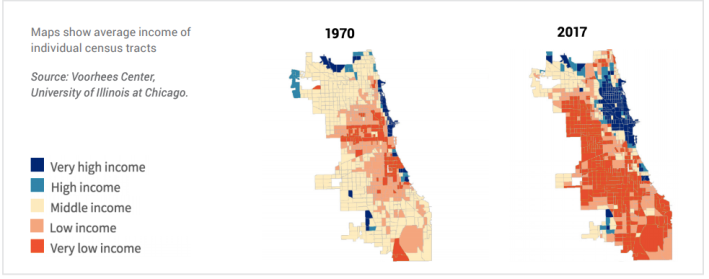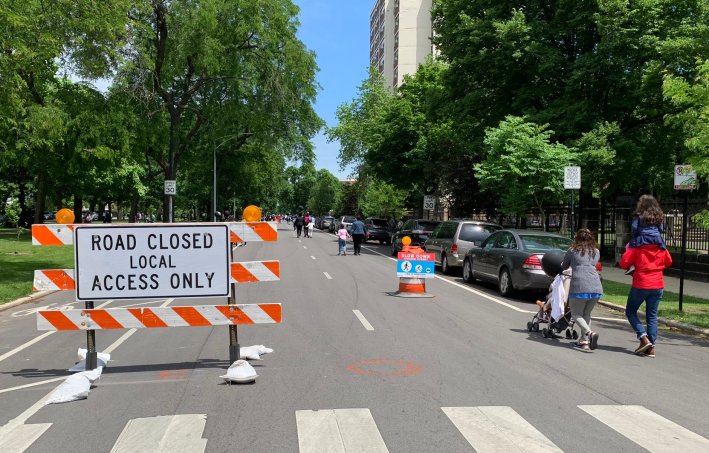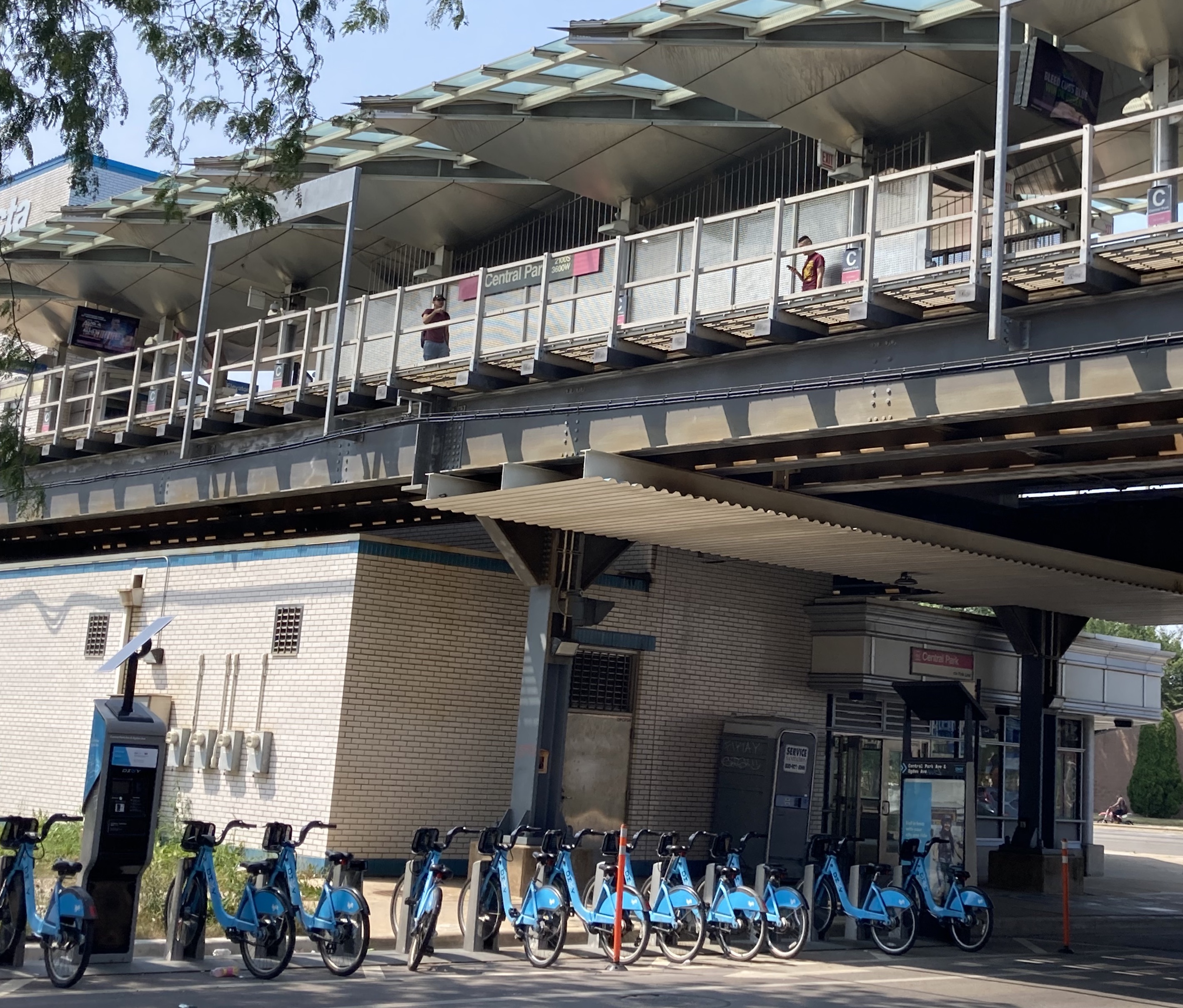Last week, the Chicago Department of Transportation released an ambitious, 80-plus page Strategic Plan for Transportation created with input from the Transportation Equity Network, a coalition of 30 civic, community and transportation advocacy organizations, plus help from former New York City transportation commissioner Janette Sadik-Khan, who served as a consultant. The plan, drafted in the height of the pandemic, sets equity and mobility justice as a guiding star and outlines how CDOT can deploy resources to address safety, health, accessibility and environmental concerns for parts of the city most in need, setting one- and three-year benchmarks on dozens of goals.
A consistent theme through the document is prioritizing neighborhoods on the South, West and Northwest sides most affected by disinvestment, limited transportation options, higher crash rates, long commute times, and higher levels of pollution. Heat maps in the introduction of the document show that transportation costs as a percent of income are highest in the areas of the city where commute times are the longest – a one-two punch of inconvenience and expense for broad swaths of the city.

A map comparing income concentrations in 1970 versus 2017 paints an indisputable picture of the extreme inequality in Chicago. Maps of any number of fundamental human needs, from transportation access to food security to health outcomes, would show similar similar disparities. As the saying among some local data analysts goes, "There's only one map of Chicago."

With help from the Center for Neighborhood Technology, CDOT will be using a mobility and economic index to identify and prioritize improvements in neighborhoods with higher levels of hardship. Changing the way projects are prioritized means a good portion of the benchmarks in the 2021 strategic plan are about creating new decision-making methods and collecting data. For example, strategies include creating neighborhood bike network planning groups in three West Side communities; working with the Chicago Department of Planning and Development on an Equitable Transit-Oriented Development (eTOD) ordinance; reinstating CDOT crash reporting and bicycle ridership counts; and creating a process for communities to request implementation of Slow Streets.
The plan sets a few dozen quantifiable goals as well, organized under four “pillars”: access to opportunity, aligning our streets with our values, streets free from violence, and a CDOT that works. The first pillar encompasses goals for pedestrian and cycling safety, and reduction of commute times and congestion. Year one goals include:
- Compete Streets pedestrian improvements on 10 miles of Illinois Department of Transportation roadways.
- 8,000 new ADA sidewalk ramps.
- Upgrading 50 traffic signals annually
- Adding 50 pedestrian countdown signals citywide
- Eliminating 5 miles of gaps in the bicycle network
- Working with IDOT to add three protected bike lanes on state routes by year three
- Installing 200 new Divvy stations
- Piloting e-bike charging stations at 15 Divvy locations
- 50 new transit priority signal intersections
- One or two new pop-up bus lanes
That last target doesn’t sound nearly ambitious enough: Cities like Boston and San Francisco have far outpaced Chicago in adopting dedicated bus lanes to address crowding and meet the commuting needs of essential workers. On the other hand, this section also promises the addition of 50 miles of bike lane network expansion – a 2019 mayoral campaign promise from Mayor Lori Lightfoot that she hasn't yet fulfilled.
Pillar two, “aligning our streets with our values,” covers infrastructure repair and environmental impacts, including pollution caused by freight. The first major goal under this category is to come up with a new method of prioritizing projects, based on equity, safety, and infrastructure conditions – a plan to make a plan, as it were. Year one targets involve lining up the requisite pieces for good decision-making: setting targets for resurfacing and repair, establishing working groups, collecting 311 data, and making project selection criteria available to public.
The same goes for many of the targets under air and water quality improvement: analyzing the CDOT fleet, updating Sustainable Urban Infrastructure Guidelines, and relaunching the Drive Clean Truck Program. I was happy to see that establishing a citywide truck route network was on the list of strategies, a change that would have big impacts on reducing emissions, improving bike and pedestrian safety, and reducing road surface wear and tear in South Side neighborhoods. CDOT aims to have a route network finalized by year three.
Measurable year-one targets under this pillar include:
- Installing one green alley per ward per year
- Upgrading 270,000 streetlights and reducing street lighting energy by 50 percent
- Commencing eight bridge construction projects
- Rehabilitating five viaduct underpasses
- Repaving 67 miles of arterial streets per year
Some notable 3-year targets include installation of 12 electric vehicle charging stations and replacement of 300 CDOT trucks and buses with electric or hybrid models.
The third pillar, “streets free from violence” encompasses safer driving, Vision Zero (the goal of eliminating all serious or fatal crashes), and ways CDOT can contribute to the vibrancy of city streets. The top two strategies for reducing dangerous driving could have a big impact on pedestrian and cyclist safety: Incorporating safe design principles and traffic calming features into resurfacing projects, and drafting state legislation to reduce the default speed limit on residential streets to 20 miles per hour. Together, these measures would reduce the likelihood of crashes and dramatically increase the survival rate of anyone struck by a driver.
Commitments to Vision Zero include creating a staff lead for the initiative at CDOT, creating a Vision Zero downtown plan, and relaunching the Vision Zero advisory group with greater representation from communities of color. It’s great to see a commitment to incorporating Vision Zero into policy and design, and I hope the renewed energy results in a significant drop of crashes and fatalities in our city.

CDOT’s plans for more vibrant streets includes expanding staffing and trainee enrollment in Greencorps Chicago – a landscaping, eco-restoration and tree care job training program for people with barriers to employment – and deploying Greencorps to restore vacant lots, plant thousands of trees and incorporate community art in greening programs. The plan also includes creating processes for communities to request Slow Streets and create an annual Slow Streets program. I would have liked to see a target number of Slow Streets to be implemented in year one, but the commitment to expanding the program is a step in the right direction. Other vibrant street strategies include permanently adopting expanded outdoor dining permits for restaurants and expanding the Make Way for People street activation program.
The final pillar, “a CDOT that works,” looks inward, at how the department can operate more efficiently, improve responsiveness to communities, and be a better employer. Overall, CDOT’s three-year plan maps out overarching structural changes and numerous incremental steps to make Chicago’s transportation landscape more equitable. CDOT commissioner Gia Biagi told Streetsblog co-editor John Greenfield she expects to be held accountable to all the goals outlined in the plan. We’ll be paying attention to progress and report back.





